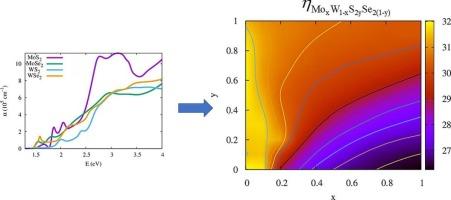过渡金属二硫系合金太阳能电池的效率限制
IF 4.6
3区 材料科学
Q2 MATERIALS SCIENCE, MULTIDISCIPLINARY
引用次数: 0
摘要
在这项研究中,二元、三元和四元过渡金属二硫族化物合金的效率极限被评价为薄膜厚度、光捕获和非辐射复合的有害影响的函数。为此,采用了实验测量的吸收光谱、各种形式和不同的太阳光谱。结果表明,效率和电流随着薄膜厚度和光捕获的增加而增加,尽管以降低电压为代价。在所有情况下,非辐射复合都降低了效率和电压。从结果来看,薄至1nm (10nm)的薄膜可以通过光捕获实现高达14%(29%)的功率转换效率。没有LT,这些值大大降低到1%(7%)。本文章由计算机程序翻译,如有差异,请以英文原文为准。

Efficiency limits of solar cells based on transition metal dichalcogenide alloys
In this study the efficiency limits of binary, ternary and quaternary transition metal dichalcogenides alloys are evaluated as a function of film thicknesses, light-trapping, and the detrimental impact of non-radiative recombination. To achieve this, experimentally measured absorption spectra, various formalisms, and different solar spectra have been employed. The results show that efficiency and current increase with film thickness and light-trapping, albeit at the expense of reduced voltage. In all cases, non-radiative recombination reduces both efficiency and voltage. From the results, films as thin as 1 nm (10 nm) could achieve up to 14 % (29 %) power conversion efficiency with light-trapping. Without LT these values are considerably reduced to 1 % (7 %).
求助全文
通过发布文献求助,成功后即可免费获取论文全文。
去求助
来源期刊

Materials Science and Engineering: B
工程技术-材料科学:综合
CiteScore
5.60
自引率
2.80%
发文量
481
审稿时长
3.5 months
期刊介绍:
The journal provides an international medium for the publication of theoretical and experimental studies and reviews related to the electronic, electrochemical, ionic, magnetic, optical, and biosensing properties of solid state materials in bulk, thin film and particulate forms. Papers dealing with synthesis, processing, characterization, structure, physical properties and computational aspects of nano-crystalline, crystalline, amorphous and glassy forms of ceramics, semiconductors, layered insertion compounds, low-dimensional compounds and systems, fast-ion conductors, polymers and dielectrics are viewed as suitable for publication. Articles focused on nano-structured aspects of these advanced solid-state materials will also be considered suitable.
 求助内容:
求助内容: 应助结果提醒方式:
应助结果提醒方式:


